JASO-C615-1989独立悬架球头台架试验规程
汽车制动性能台架试验检测法
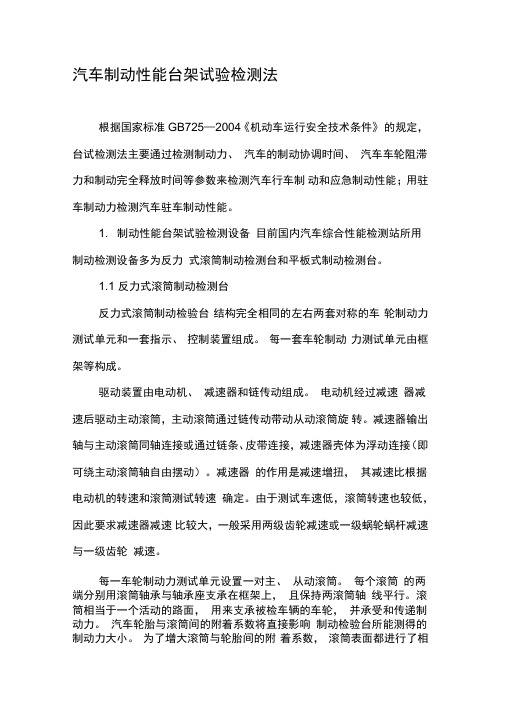
汽车制动性能台架试验检测法根据国家标准GB725—2004《机动车运行安全技术条件》的规定,台试检测法主要通过检测制动力、汽车的制动协调时间、汽车车轮阻滞力和制动完全释放时间等参数来检测汽车行车制动和应急制动性能;用驻车制动力检测汽车驻车制动性能。
1. 制动性能台架试验检测设备目前国内汽车综合性能检测站所用制动检测设备多为反力式滚筒制动检测台和平板式制动检测台。
1.1 反力式滚筒制动检测台反力式滚筒制动检验台结构完全相同的左右两套对称的车轮制动力测试单元和一套指示、控制装置组成。
每一套车轮制动力测试单元由框架等构成。
驱动装置由电动机、减速器和链传动组成。
电动机经过减速器减速后驱动主动滚筒,主动滚筒通过链传动带动从动滚筒旋转。
减速器输出轴与主动滚筒同轴连接或通过链条、皮带连接,减速器壳体为浮动连接(即可绕主动滚筒轴自由摆动)。
减速器的作用是减速增扭,其减速比根据电动机的转速和滚筒测试转速确定。
由于测试车速低,滚筒转速也较低,因此要求减速器减速比较大,一般采用两级齿轮减速或一级蜗轮蜗杆减速与一级齿轮减速。
每一车轮制动力测试单元设置一对主、从动滚筒。
每个滚筒的两端分别用滚筒轴承与轴承座支承在框架上,且保持两滚筒轴线平行。
滚筒相当于一个活动的路面,用来支承被检车辆的车轮,并承受和传递制动力。
汽车轮胎与滚筒间的附着系数将直接影响制动检验台所能测得的制动力大小。
为了增大滚筒与轮胎间的附着系数,滚筒表面都进行了相应加工与处理,目前采用较多的有下列五种:1.1.1 开有纵向浅槽的金属滚筒,在滚筒外圆表面沿轴向开有若干间隔均匀、有一定深度的沟槽。
这种滚筒表面的附着系数最高可达0.65 。
当表面磨损且沾有油、水时,附着系数将急剧下降。
为改进附着条件,有的制动台表面进一步作拉花和喷涂处理,附着系数可达0.75 以上。
1.1.2 表面粘有熔烧铝矾土砂粒的金属滚筒。
这种滚筒表面无论干或湿时其附着系数可达0.8 以上。
1.1.3 表面具有嵌砂喷焊层的金属滚筒,喷焊层材料选用NiCrBSi 自熔性合金粉末及钢砂。
悬架作业指导书20171115

悬架检测作业指导书一、注意事项1.1 参考标准参考标准为《JT/T448-2008汽车悬架装置检测台》《GB18565-2016道路运输车辆综合性能要求和检验方法》《JJF 1192-2008汽车悬架装置检测台校准规范》1.2 检测对象与评价标准检测对象设计车速不小于100km/h,轴质量不大于1500kg的载客汽车评价标准轮胎在激励振动条件下测得的悬架吸收率应不小于40%,同轴左、右轮悬架吸收率之差不得大于15%。
1.3 检测评判限值轮胎在激励振动条件下测得的悬架吸收率应不小于40%,同轴左、右轮悬架吸收率之差不得大于15%。
1.4 检测结果判定方法1) 当检测中实测的悬架吸收率小于40%,则认为吸收率不合格2) 当检测中实测的同轴左、右轮悬架吸收率之差大于15%,则认为吸收率不合格1.5 被检车辆要求1) 检验方法中如无特别说明,被检车辆均为空载2) 被检车辆的车身、驾驶室、发动机舱、车厢、底盘和照明信号装置应清洁、无油污。
3) 被检车辆应随车携带行驶证,机动车登记证复印件和产品说明书1.6 录入数据要求无需录入数据1.7 使用注意事项1) 超出悬架台额定载荷的汽车,禁止驶上悬架台2) 不要在悬架台上停放车辆和堆积杂物,严禁做空载实验3) 不要对肮脏的车辆直接检测,特别是轮胎和底盘部分粘有较多泥土的车辆,应首先清洗并待滴水较少时进行检测4) 雨天检测必须为车辆除水,滴水较少时才能检测5) 严禁悬架台中进水,保持传感器清洁、干燥和正常工作。
6) 为保证测试精度,传感器应预热30min二、检测过程1) 将被检车辆各轴车轮依次驶上悬架装置检测台,并使轮胎位于检测台面的中央位置,测量左、右轮的静态轮荷。
2) 分别起动悬架检测台的左、右电动机,使汽车悬架产生振动,增加振动频率并超过振动的共振频率。
3) 当振动频率超过共振点后,将电机关断,振动频率衰减并通过共振点。
4) 记录衰减振动曲线,测量共振时的最小动态轮荷,计算并读取最小动态轮荷与静态轮荷的百分比以及同轴左、右轮百分比的差值。
日本早期汽车减震器标准JASO C
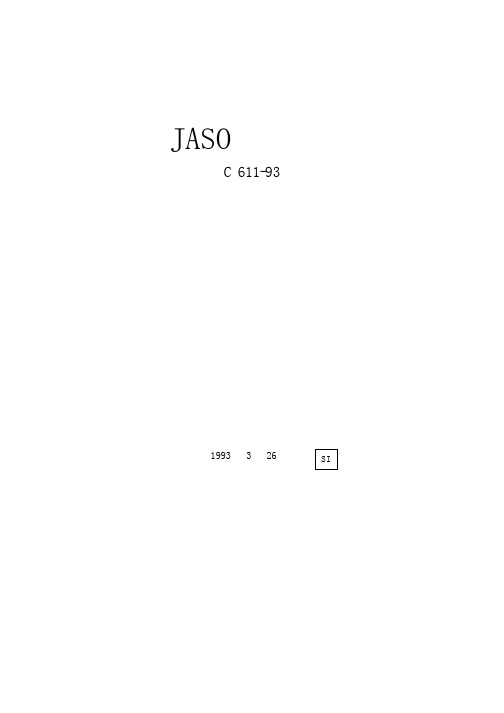
JASO汽车标准C 611-93悬架用滑柱式减振器1993年3月26日修订标准会议审议(社团法人汽车技术会发行)悬架用滑柱式减振器分科学会组成名单姓名所属(分科会长)大继直人大发工业有限公司底盘设计部(干事)古谷洋介工业有限公司岐阜北工厂设计部岩附诚有限公司昭和制作所技术第二部鹿岛英二铃木有限公司四轮传递设计部喜田诚丰田汽车有限公司第一底盘设计部木村隆东机工有限公司悬架工厂第一设计部金成逸世有限公司悬架制动机械设计部小泉公一日产汽车有限公司底盘设计部小岛克已社团法人日本汽车零件工业会尾照夫工业技术院标准部机械标准科岛田孝志富士重工业有限公司技术本部底盘设计部炭本孝志马自达有限公司第一车辆设计部外村明男有限公司本田技术研究所木研究所中村善辉三菱汽车工业有限公司轿车开发本部底盘设计部西堀稔五十陵汽车有限公司轿车。
RV设计部坊田佳纪通商产业省机械情报产业局汽车科森哲二日产柴油工业有限公司底盘设计部高野牧夫社团法人汽车技术标准部门照山滕社团法人汽车技术标准部门平野修二社团法人汽车技术标准部门第三阶段过渡标准(不用原来单位只是用新的SI单位。
但是不包括M,A,HZ等进入SI单位中单位部份,)社团法人汽车技术会标准会议制定制定日期:1981年2月19日修订日期:1993年3月26日原稿制作分科会:原稿制作审议部会:底盘部会审议委员会:底盘部会社团法人汽车技术会发行(东京都千代田区五番町10番2号)1. 适用范围该标准对汽车悬架用滑柱式减振器(以下称为滑柱减振器)的滑柱减振器主体进行了规定。
备注:该标准中引用了下述标准 JIS D 0202 汽车零件的涂装标准。
2. 术语定义该标准所用的主要术语定义如下:(1)滑柱减振器主体是指用贮油缸包着的部分及转向节支架,不包括弹簧座和转向节等(见图1)。
(2)转向节支架是指贮油缸与转向节连接的部分。
连接形式有焊接转向节的形式和借助支架用螺栓固定转向节形式及直接用螺栓固定螺转向节形式等。
日本汽车工业协会标准(jaso)

日本汽车工业协会标准标准号标准名称页数JASO B001-1997警告牌样式12 JASO B002-1989警告牌质量8 JASO B003-1989乘用车内饰件31 JASO B004-1984乘用车外部凸出物5 JASO B006-2008道路车辆—胎压监测系统—车辆试验规程11 JASO B101-1983载货车车架总宽度3 JASO B102-1987汽车保险杠高度8 JASO B105-1993载货车和挂车后下防护装置8 JASO B106-1985商用车驾驶室乘员的防护11 JASO B203-1990汽车发动机罩盖锁系统试验规程7 JASO B204-1981载货车车身连接件形状和尺寸14 JASO B205-1986汽车滑动车门锁止系统试验规程6 JASO B301-1989乘用车燃油系统安全性试验规程16 JASO B302-1994乘用车塑料油箱9 JASO B404-1993汽车遮阳板9 JASO B407-1987汽车座椅舒适性试验规程12 JASO B409-1982汽车悬挂座椅舒适性试验规程15 JASO B801-1986汽车座椅词汇27 JASO B802-1988乘用场车身词汇18 JASO B803-1995汽车气囊系统词汇22 JASO C101-1989汽车离合器盖总成22 JASO C102-1989汽车离合器盘总成15 JASO C103-1995液压离合器主缸11 JASO C104-1995液压离合器动力油缸9 JASO C201-2007动液变矩器试验规程19 JASO C203-1985手动变速器台架性能试验规程13 JASO C204-1986手动变速器台架耐久性试验规程13 JASO C205-1991汽车动力动力输出装置侧开口12 JASO C206-1993汽车动力输出装置的双层外壳及壳间间隙9 JASO C303-1986汽车车轮配重块9 JASO C304-1989汽车半轴等速万向节22 JASO C305-1-2009汽车部件—无铅车轮平衡重—第1部分:夹型19 JASO C305-2-2009汽车部件—无铅车轮平衡重—第1部分:粘接型5 JASO C401-1987液压制动器油缸形状和尺寸25 JASO C402-1999乘用车—行车制动器道路试验规程32 JASO C404-1999载货车和大客车—行车制动器道路试验规程23 JASO C406-2000乘用车—制动装置—测功机试验规程9 JASO C407-2000载货车和大客车—制动装置—测功机试验规程9 JASO C417-1988行车制动器结构整体性试验规程—乘用车14JASO C418-1991制动衬片摩擦特性试验规程11 JASO C419-2006乘用车—行车制动器—结构整体性测功机试验规程12 JASO C420-2005载货车和大客车—行车制动器结构整体性试验规程18 JASO C421-2005载货车和大客车—行车制动器结构整体性测功机试验规程13 JASO C427-2009汽车部件—制动衬片和盘式制动蹄—惯性测功机上的磨损试验17 JASO C428-2001道路车辆—驻车制动器试验规程6 JASO C430-2002气制动器试验规程22 JASO C432-2001伺服制动器试验规程9 JASO C436-1999驻车制动装置测功机试验规程17 JASO C438-2008道路车辆—行车制动器—模拟山区车辆制动器衰退试验规程27 JASO C439-2002应急制动器道路试验规程19 JASO C441-1977行车制动器耐久性台架试验规程10 JASO C442-1977驻车制动器结构整体性测功机试验规程15 JASO C443-2009道路车辆—行车制动—测功机模拟山路消退试验17 JASO C447-1979驻车制动器结构整体性道路试验规程11 JASO C448-1980乘用车—钳盘式制动器台架试验规程25 JASO C449-1980气制动器松紧调节器9 JASO C452-2005汽车部件—制动器真空伺服单元20 JASO C454-1983直线制动时方向稳定性试验规程—乘用车10 JASO C455-2004道路车辆—缓速器道路试验规程17 JASO C456-1984磨损警报装置试验规程9 JASO C457-1985汽车制动器制动气室12 JASO C458-1986汽车制动衬片、制动块和离合器表面PH值试验规程8 JASO C459-1987载货车和大客车—盘式制动器卡箝台架试验规程25 JASO C460-1988真空伺服制动器真空泵试验规程18 JASO C461-1988汽车制动器气制动阀9 JASO C462-1989汽车制动器气继动阀12 JASO C463-1993汽车比例阀台架试验规程35 JASO C464-1994装备ABS系统车辆障碍物躲避性能试验规程13 JASO C465-1997装备ABS系统的乘用车性能试验规程18 JASO C466-2004道路车辆—制动距离试验规程8 JASO C467-1997ABS用车轮速度传感器19 JASO C501-2003汽车列车—行车制动器道路试验规程15 JASO C601-1998汽车零部件—钢板弹簧13 JASO C602-2001汽车零部件—汽车筒式减振器39 JASO C604-1999汽车悬架弹簧—强度试验方法21 JASO C605-1997汽车悬架螺旋弹簧6 JASO C606-1981轮胎噪声试验规程10 JASO C610-1979汽车轮毂螺栓17 JASO C611-1993汽车悬架支柱13 JASO C612-2004汽车扭杆15 JASO C613-1987载货车和大客车空气弹簧12JASO C614-2004汽车辐板式车轮32 JASO C615-1989独立悬架球头台架试验规程18 JASO C616-1994载货车和大客车平衡阀14 JASO C617-2002汽车部件—稳定杆19 JASO C618-2003轮胎/车轮总成高速行驶一致性试验规程7 JASO C704-2004道路车辆—转向力(转弯时)试验规程8 JASO C705-2004道路车辆—静态转向力试验规程5 JASO C707-2004乘用车—轻型挂车列车—车道变换试验规程14 JASO C708-2004乘用车—轻型挂车列车—转弯性能试验规程19 JASO C709-2004乘用车—轻型挂车列车—蛇行试验规程12 JASO C712-1982动力转向泵性能台架试验规程13 JASO C713-1996汽车转向轮17 JASO C715-2005道路车辆—转向球节台架试验规程21 JASO C716-1990转向轴节台架性能试验规程8 JASO C717-1991齿条和行星齿轮类手动转向器台架试验规程22 JASO C801-1994汽车手动变速器词汇37 JASO C802-1994汽车自动变速器词汇44 JASO C803-1986汽车驱动轴词汇23 JASO D005-1993汽车螺线管试验方法通用规则11 JASO D006-1995汽车串行数据通信系统试验方法29 JASO D009-1999汽车零部件—印刷线路板电磁继电器试验方法14 JASO D102-2005汽车零部件—36V铅酸电池端子2 JASO D303-2003汽车零部件—发动机电子转速计5 JASO D305-1998汽车零部件—汽车时钟试验15 JASO D404-1986汽车发动机冷却系统温度计应用开关9 JASO D506-1999汽车零部件—汽车附件电气出口和火花塞10 JASO D507-1-2004汽车零部件—车用天线—术语16 JASO D507-2-2003汽车零部件—车用天线—第2部分:插销、插座和接头14 JASO D507-3-2007汽车零部件—车用天线—第3部分:性能要求和测量方法67 JASO D603-1990汽车低压铝线缆3 JASO D605-1996汽车电子插接器15 JASO D607-1999汽车零部件—线束颜色代码4 JASO D609-2001汽车零部件—低压电缆的电流容量35 JASO D611-2009汽车零部件—无屏蔽式低压电缆27 JASO D612-1997汽车叶片型熔断器10 JASO D613-1990半挂牵引车和拖车间制动防报死装置插接器12 JASO D615-1994无屏蔽高压点火电缆总成—一般要求和试验方法7 JASO D618-2008汽车零部件—无屏蔽低压电缆试验方法34 JASO D620-2003汽车—电气电子接头用铜合金带7 JASO D621-2004汽车零部件—42V熔断器—第1部分:定义和一般试验要求22 JASO D622-2006汽车零部件—栓入式高压熔断器12 JASO D801-1996汽车电子系统和相关零部件词汇47JASO D802-2001汽车空调术语18 JASO D805-2000汽车零部件—电子及视觉连接件术语33 JASO D901-1996汽车倒车警报器6 JASO D902-1995汽车电子装置耐久性试验方法22 JASO D903-1999道路车辆—SRS气囊系统的布置18 JASO E002-1989曲轴箱排放控制系统试验规程15 JASO E004-1992汽车尾气CVS取样法18 JASO E101-1985汽车发动机气门9 JASO E103-1983汽车滚子链和套筒链9 JASO E104-1985汽车发动机气门锁片7 JASO E105-1999汽车零部件—同步滑轮9 JASO E106-1999汽车零部件—同步皮带11 JASO E107-2001汽车V型皮带及其皮带轮槽17 JASO E109-1994汽车V形橡胶带16 JASO E110-2000汽车等速皮带试验方法13 JASO E111-1993汽车发动机V形橡胶皮带轮套尺寸10 JASO E121-2002汽车部件—V形皮带—疲劳试验12 JASO E201-1985汽车柴油发动机燃油滤清器尺寸6 JASO E202-1986汽车汽油发动机一次性燃油滤清器尺寸4 JASO E203-2005压缩天然气车辆——燃料加注接头9 JASO E204-2002压缩天然气—气缸压力释放装置—性能要求12 JASO E205-2003压缩天然气—开关阀—性能要求11 JASO E207-2006压缩天然气—管接头和管路—性能要求15 JASO E302-2003汽车旋入式燃油滤清器尺寸5 JASO E401-1997汽车散热器10 JASO E402-1991恒温器13 JASO E403-2000汽车水泵机械密封圈5 JASO E404-1986汽车机油冷却器散热试验规程13 JASO E405-1994汽车自动变速器机油冷却器散热试验方法8 JASO E406-1995汽车中间冷却器散热试验方法9 JASO E501-1990汽车蒸发排放物控制系统炭罐试验方法13 JASO E801-1992汽车涡轮增压器词汇13 JASO F101-2005汽车零部件—六角螺栓和六角螺钉27 JASO F102-2005汽车零部件—六角螺母和六角细螺母11 JASO F106-1996六角锁紧螺母31 JASO F107-1998汽车零部件—弹性螺母4 JASO F109-2002螺栓或螺钉和垫圈总成25 JASO F115-1998汽车零部件—螺钉用垫圈10 JASO F116-2005六角叶片状扳手紧固件47 JASO F118-1999汽车零部件—六角头螺母和垫圈总成9 JASO F120-1999汽车零部件—自攻螺钉和平垫圈总成15 JASO F121-1985带套管的螺钉9JASO F122-1988六角紧固螺钉10 JASO F123-1991带套管的平头自攻螺钉8 JASO F124-1994合成树脂材料用自攻螺钉16 JASO F125-2004汽车零部件—锁止紧固件性能和试验方法9 JASO F203-2002汽车卡销13 JASO F204-1999汽车零部件—汽车弹簧作用型软管夹12 JASO F205-1996管路和线路用夹子27 JASO F206-1992盲孔铆钉22 JASO F207-1999汽车零部件—涡轮传动型软管夹8 JASO F208-2008汽车零部件—内外饰件用塑料夹22 JASO F302-2000汽车波型垫圈10 JASO F304-2000汽车零部件—圆形软垫圈6 JASO F402-2001汽车扩口管接头24 JASO F403-2002汽车无扩口管接头15 JASO F404-1996汽车O形环26 JASO F405-1999汽车零部件—放水开关11 JASO F408-1998汽车零部件—盲塞7 JASO F409-2006汽车零部件—尼龙管接头—性能要求17 JASO F411-2000汽车零部件—金属密封垫圈4 JASO F501-1989汽车万向节滚针轴承15 JASO F503-1995汽车成形衬套16 JASO F506-2001汽车零部件—扁轴承—衬套15 JASO F901-1970球头销和球座36 JASO F903-1975汽车控制缆线34 JASO F904-1998汽车零部件—金属孔12 JASO M101-1994汽车用金属管13 JASO M102-1978汽车结构件烧结材料17 JASO M104-1986汽车制动管试验方法19 JASO M106-1992汽车结构用钢34 JASO M110-1997汽车结构用微合金钢5 JASO M111-1998压缩天然气车辆—高压用强化纤维塑料燃料软管—性能要求10 JASO M303-1995汽车非金属密封片材料19 JASO M304-2002汽车用泡沫塑料20 JASO M305-1988汽车密封条25 JASO M310-1993汽车散热器抑制剂14 JASO M312-1985汽车塑料件试验方法20 JASO M315-2004自动变速器液12 JASO M316-1980汽车燃油软管6 JASO M317-2001汽车气制动尼龙管7 JASO M318-1978汽车窜缸混合气软管8 JASO M319-1980汽车软管标准试验方法16 JASO M321-1999汽车零部件—空调软管总成8JASO M328-1995汽车汽油发动机油评估气门系统磨损试验规程34 JASO M330-1987汽车硬质塑料安全玻璃材料18 JASO M331-1991低温和常温下汽车汽油发动机燃油洗涤剂评估试验规程36 JASO M332-1986汽车软质塑料安全玻璃12 JASO M334-1986汽车外饰薄膜9 JASO M336-1998汽车柴油发动机油—洗涤剂试验规程32 JASO M337-1989汽车燃油加注软管10 JASO M338-1989汽车玻璃黏合剂28 JASO M340-2003二冲程汽油发动机—发动机油—润滑性试验规程26 JASO M341-2003二冲程汽油发动机—发动机油—去垢性试验规程25 JASO M342-2003二冲程汽油发动机—发动机油—烟度试验规程24 JASO M343-2003二冲程汽油发动机—发动机油—排气系统堵塞试验规程26 JASO M344-1992汽车齿轮油与橡胶密封材料兼容性试验规程7 JASO M345-2003二冲程汽油发动机—发动机油—分类6 JASO M346-1993汽车内饰件氙气弧光灯轻度照射试验方法20 JASO M347-1995自动变速器液剪切稳定性试验方法9 JASO M348-2002自动变速器液摩擦特性试验方法18 JASO M349-2001道路车辆—自动变速器液抗不稳定性试验方法20 JASO M350-1998自动变速器液—与塑料材料的兼容性试验3 JASO M351-1998汽车零部件—外饰件氙弧灯加速老化试验方法9 JASO M352-1998汽车汽油发动机—添加剂裂化引起的燃烧室沉积物台架试验规程12 JASO M353-1998汽车—结构附着剂—试验方法32 JASO M354-2006汽车柴油机油—气门系统磨损试验42 JASO M355-2008汽车柴油机油9 JASO M357-2001道路车辆—自动变速器液与湿磨擦材料兼容性试验方法22 JASO M358-2005带式CVT液金属磨擦特性标准金属试验方法19 JASO M359-2005道路车辆—直喷汽油机沉积物的评价41 JASO M360-2006汽车燃油—作为混合原料的FAME14 JASO M361-2006汽车燃油—作为混合原料的乙醇8 JASO M404-1984汽车地毯12 JASO M406-1987汽车玻璃纤维强化塑料25 JASO M501-1994汽车安全玻璃22 JASO M601-1989汽车电镀塑料零部件8 JASO M607-1986汽车塑料零部件热冲压9 JASO M608-1990装饰用塑料零部件真空喷镀8 JASO M609-1991汽车材料锈蚀试验方法14 JASO M610-1992汽车零部件外涂层腐蚀试验方法12 JASO M611-1992汽车消声器内部锈蚀试验方法11 JASO M612-1992汽车防锈蜡试验方法24 JASO M801-1993塑料产品种类标识和标记系统11 JASO M902-2007道路车辆—内饰件和材料—VOC测量方法11 JASO T001-1997摩托车控制电缆33JASO T003-2009摩托车—骑乘位置6 JASO T004-1989摩托车尺寸、重量和载荷测量方法6 JASO T005-2009摩托车—驾驶员视野12 JASO T006-2007摩托车—H点确定规程8 JASO T007-1987摩托车最小转弯半径试验规程6 JASO T008-1988摩托车加速噪声的测量8 JASO T009-2009摩托车—后视镜测量方法11 JASO T010-1992支架在侧部和中部的摩托车的驻车稳定性5 JASO T011-2003摩托车—稳态转弯试验9 JASO T012-2005摩托车—侧向瞬态响应试验规程11 JASO T013-2007摩托车—车道变换试验规程21 JASO T102-1984摩托车把手宽度及抓握角度4 JASO T103-2004摩托车—导流罩9 JASO T201-1977摩托车制动踏板强度试验规程和要求(包括JASO T 202)8 JASO T202-1977摩托车制动杆强度试验规程及要求(包括JASO T 201)9 JASO T203-1985摩托车轻合金车轮12 JASO T204-2001摩托车—制动装置—测功机试验规程13 JASO T206-2005摩托车—车轮平衡块9 JASO T304-1986摩托车点火线圈6 JASO T802-1988摩托车座椅词汇11 JASO T902-1995摩托车和轻便摩托车—两冲程汽油发动机可见烟度测量方法10 JASO T903-2006摩托车—四冲程汽油发动机油11 JASO T904-2006摩托车—四冲程汽油发动机油—离合器磨擦特性试验规程11 JASO T905-1999摩托车—塑料燃油箱—试验方法和性能要求5 JASO T906-2002摩托车—燃料箱—空气密闭性试验方法12 JASO Z003-1990汽车性能图解格式11 JASO Z006-1992牵引车、半挂车和全挂车组合90°转向场所图解格式14 JASO Z013-1986乘用车驾驶员手动控制范围检查规程5 JASO Z014-1990载货车和挂车后牌照板16 JASO Z105-1984乘用车移动蔽障后碰撞试验规程11 JASO Z107-2004铰接列车—最小稳定转弯半径试验规程12 JASO Z110-1991乘用车瞬时响应试验规程11 JASO Z112-1988汽车接近角、离去角和坡道翻车角测量方法4 JASO Z114-1996乘用车转向中油门关闭试验规程10 JASO Z115-1999汽车空调—冷凝器损耗试验方9 JASO Z116-1999汽车空调—蒸发器冷却性能试验方法8 JASO Z120-2004汽车空调—低温冷凝器损耗试验方法15 JASO Z123-2007汽车零部件—空调—制冷剂(R134a)泄露量测量方法15 JASO Z125-2009道路车辆—内饰件—VOC测量方法11 JASO Z202-2004汽车零部件—管接头—词汇16 JASO Z211-1983汽车安全词汇26 JASO Z213-1989汽车转向系统词汇52JASO Z214-1987汽车振动和噪声词汇35 JASO Z216-1990载货车车身词汇28 JASO Z217-1991汽车安全带词汇19 JASO Z218-1982汽车空气动力学特性词汇60 JASO Z219-2005道路车辆—维修用词汇—发动机和底盘30。
减震器技术标准与台架试验方法

QC/T ××××—××××汽车减振器技术条件与台架试验方法汽车减振器技术条件与台架试验方法1 范围本标准规定了汽车减振器技术条件和台架试验方法。
本标准适用于汽车悬架用减振器及驾驶室悬置用减振器。
2 术语和定义下列术语和定义适用于本标准。
2.1双筒式减振器无导向作用的、由工作缸和外筒组成的减振器。
2.2支柱式减振器由工作缸、外筒及其他部件,如弹簧盘、支架等组成的减振器,通常起悬架导向作用,承受侧向力,故活塞杆直径相应较大。
2.3示功特性(阻力特性)减振器在规定的行程和试验频率下,两端作相对简谐运动,其阻力(F)随位移(S)的变化关系为阻力特性,其所构成的曲线(F-S)称示功图。
2.4速度特性减振器在规定的行程和多种试验频率下,两端作相对简谐运动时,其阻力(F)与速度(V)的关系为速度特性。
在多种速度下所构成的曲线(F-V)称速度特性图。
2.5温度特性减振器在规定的速度下,并在多种温度的条件下,所测得的阻力(F)随温度(t)的变化关系为温度特性,其所构成的曲线(F-t)称温度特性图。
2.6耐久特性减振器在规定的工况条件下,在规定的运转次数后,其特性的变化称为耐久特性。
2.7摩擦力(Fm)减振器以≤0.005m/s的速度,其力定义为摩擦力。
2.8充气力(Fc)对于充气减振器,活塞处于行程的中间位置时,气体作用于活塞杆上的力为充气力。
2.9抗泡沫性减振器在规定的条件下,重复运动后,减振器内的油可能产生泡沫。
其示功特性抗泡沫影响的能力。
3 符号和缩略语额定阻力F (N)额定复原阻力Ff (N)额定压缩阻力Fy (N)行程S (mm)试验频率 f (Hz)活塞速度V (m/ s)摩擦力Fm (N)复原时摩擦力Fmf (N)压缩时摩擦力Fmy (N)温度特性试验时,试验前、后复原及压缩阻力的变化率εf , εy台架耐久性试验时,试验前、后复原及压缩阻力的变化率εnf ,εnyL1:最小压缩长度S:行程L1+S:最大拉伸长度D2:防尘罩外径D1:贮液缸外径M:螺纹连接尺寸HH:两端吊环型HG:上端吊环下端螺杆型GH:下端吊环上端螺杆型GG:两端螺杆型4.2.3 减振器的工作行程及长度按照实际需要设定。
新能源汽车台架试验相关标准-概述说明以及解释
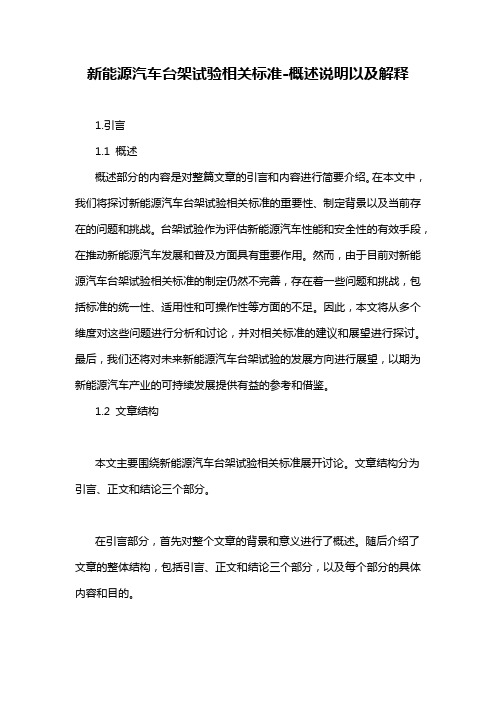
新能源汽车台架试验相关标准-概述说明以及解释1.引言1.1 概述概述部分的内容是对整篇文章的引言和内容进行简要介绍。
在本文中,我们将探讨新能源汽车台架试验相关标准的重要性、制定背景以及当前存在的问题和挑战。
台架试验作为评估新能源汽车性能和安全性的有效手段,在推动新能源汽车发展和普及方面具有重要作用。
然而,由于目前对新能源汽车台架试验相关标准的制定仍然不完善,存在着一些问题和挑战,包括标准的统一性、适用性和可操作性等方面的不足。
因此,本文将从多个维度对这些问题进行分析和讨论,并对相关标准的建议和展望进行探讨。
最后,我们还将对未来新能源汽车台架试验的发展方向进行展望,以期为新能源汽车产业的可持续发展提供有益的参考和借鉴。
1.2 文章结构本文主要围绕新能源汽车台架试验相关标准展开讨论。
文章结构分为引言、正文和结论三个部分。
在引言部分,首先对整个文章的背景和意义进行了概述。
随后介绍了文章的整体结构,包括引言、正文和结论三个部分,以及每个部分的具体内容和目的。
接下来是正文部分,主要包括台架试验的重要性、相关标准的制定背景以及当前存在的问题和挑战三个方面的内容。
在台架试验的重要性方面,我们将探讨为何台架试验对新能源汽车的发展至关重要,以及台架试验在车辆性能、能耗、安全性等方面的作用和意义。
在相关标准的制定背景方面,我们将介绍国内外关于新能源汽车台架试验相关标准的发展历程和现状。
最后,在当前存在的问题和挑战方面,我们将分析当前新能源汽车台架试验所面临的问题,如试验方法的不统一、标准的缺失等,并提出解决方案和对策。
最后是结论部分,我们将对整个文章进行总结,归纳出台架试验的作用和意义,以及对相关标准的建议和展望。
在对相关标准的建议和展望方面,我们将提出如何完善和统一台架试验相关标准的建议,并展望未来可能的发展趋势和方向。
通过以上的结构安排,本文将全面深入地探讨新能源汽车台架试验相关标准的重要性、背景、问题和挑战,并提出相应的建议和展望,为新能源汽车台架试验相关标准的制定和发展提供有益的参考和指导。
汽车球头销台架试验标准
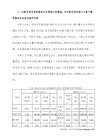
前言本标准以符合国家标准和行业标准为前提,在立足市场需求和产品性能的实际情况下指定的。
同时在格式和内容编排上均符合GB/T1.1-2000和GB/T1.2-2002规定。
本标准由XXXX机械有限公司提出本标准由XXXX机械有限公司归口本标准起草单位:XXXX机械有限公司标准起草人:XXX汽车球头销台架试验标准1 范围本标准规定了XX公司悬架使用的球销节(以下简称“球销总成”)的有关台架试验的方法和技术要求。
本标准适用于XX公司的所有汽车悬架球销总成。
2 规范性引用文件下列文件中的条款通过标准的引用而成为本标准的条款。
凡是注日期的引用文件,其随后的修改单(不包括勘误的内容)或修订版均不适合与本标准,然而,鼓励根据本标准达成协议的各方研究是否可以使用这些文件的最新版本,凡是不注日期的引用文件,其最新版本适用用本标准。
GB/T 7762-2003 硫化橡胶或热塑性橡胶耐臭氧龟裂静态拉伸试验JIS K 6301 硫化橡胶的物理试验方法3 目的本标准的目的是使球销总成的性能、强度和耐久性试验的试验方法标准化,以便得到评定质量的统一方法。
4 试验种类(1)摆角试验(2)力矩试验(3)刚度试验(4)挤压和拉伸强度试验(5)球头销静态强度试验(6)疲劳强度试验(7)工作温度下的耐磨持久性试验(8)高温下的耐磨持久试验(9)耐泥水持久性试验(10)防尘罩耐臭氧试验(11)防尘罩低温试验(12)防尘罩耐热性试验(13)防尘罩拉伸强度试验5 试验的一般条件试验条件一般适用于上面列举的所有试验,内容如下;(1)除非另有规定,试验应在常温常压下进行;(2)试验件应固定在刚度足够大的装置上,这样才不会消弱试验目的;(3)安装夹具的形状应不影响试验目的;6 球销总成试验方法6.1 摆角试验这个试验是测量球销的工作摆角,按如下方法进行6.1.1 试验装置如图1所示,把销总成安装在试验夹具上6.1.2 试验条件测量方向:如图1所示,使球头销铅垂直立,沿A方向和A方向垂直的B方向进行测量。
汽车动力性台架试验方法

汽车动力性台架试验方法1 范围本标准规定了汽车动力性的台架试验检测参数、评价指标、检测设备、检测准备、检测方法和检测结果评价等。
本标准适用于装有点燃式或压燃式发动机的在用营运车辆,其他车辆可参照使用。
2 规范性引用文件下列文件对于本文件的应用是必不可少的。
凡是注日期的引用文件,仅注日期的版本适用于本文件。
凡是不注日期的引用文件,其最新版本(包括所有修改单)适用于本文件。
GB/T 2977 载重汽车轮胎规格、尺寸、气压与负荷JT/T 445 汽车底盘测功机3 术语和定义下列术语和定义适用于本文件。
3.1驱动轮输出功率driving wheel power汽车发动机经汽车传动系至驱动轮所输出的功率。
3.2实测有效功率observed effective power发动机在实际进气状态下所输出的功率。
【GB/T 18297-2001,定义3.1】3.3校正有效功率calibrated effective power将实测有效功率校正到标准进气状态下的功率。
【GB/T 18297-2001,定义3.2】3.4总功率gross power发动机仅带维持运转所必需的附件时所输出的校正有效功率。
【GB/T 18297-2001,定义3.4】3.5额定功率rated power制造厂根据发动机具体用途,在规定的额定转速下所输出的总功率。
【GB/T 18297-2001,定义3.5】4 检测参数汽车动力性采用汽车在底盘测功机上(以下简称测功机)驱动轮的输出功率或轮边稳定车速作为检测参数。
5 评价指标5.1汽车动力性评价指标如下:a)汽车在发动机最大扭矩工况或额定功率工况时的驱动轮输出功率;b)汽车在发动机额定功率工况或最大扭矩工况时的驱动轮轮边稳定车速。
5.2 采用驱动轮轮边稳定车速作为评价指标时,压燃式发动机车辆采用额定功率工况,点燃式发动机车辆采用最大扭矩工况。
5.3在进行维修质量监督抽查或对动力性检测结果有异议时,采用驱动轮输出功率作为评价指标。
JASO

日本汽车工业协会标准编号名称JASO B001-1997 标牌样式JASO B002-1989 标牌质量JASO B004-1984 乘用车外部凸出物JASO B101-1983 货车车架宽度JASO B102-1987 汽车保险杠高度JASO B106-1985 商用车驾驶室内乘客的保护JASO B203-1990 汽车发动机罩锁扣系统代码JASO B204-1981 货车车身连接部分的形状和尺寸JASO B205-1986 汽车滑动门锁扣系统的试验规程JASO B301-1989 乘用车燃料系统安全试验规程JASO B402-1989 大客车安全带固定点JASO B404-1993 汽车遮阳板JASO B407-1987 汽车座椅舒适性试验规程JASO B409-1982 汽车悬挂座椅舒适性试验规程JASO B411-1988 货车安全带固定点JASO B801-1986 汽车座椅词汇JASO B802-1988 乘用车车身词汇JASO B803-1995 汽车气囊词汇JASO C101-1989 汽车离合器盖总成JASO C102-1989 汽车离合器从动盘总成JASO C103-1995 液压离合器主缸JASO C104-1995 液压离合器操纵油缸JASO C203-1985 手动变速箱台架性能试验规程JASO C204-1986 手动变速箱台架耐久性试验规程JASO C205-1991 汽车动力输出装置的侧开口JASO C206-1993 汽车动力输出机构箱的双层外壳及壳间间隙JASO C303-1986 汽车车轮平衡重量JASO C304-1989 汽车半轴等速万向节JASO C401-1987 液压制动油缸的形状和尺寸JASO C402-1999 乘用车——行车制动器道路试验规程JASO C403-1979 行车制动器性能要求JASO C404-1999 货车和大客车——行车制动器道路试验规程JASO C405-1981 货车和大客车——行车制动器性能要求JASO C406-2000 乘用车——制动装置——测功机试验规程JASO C407-2000 货车和大客车——制动装置——测功机试验规程JASO C417-1988 乘用车——行车制动系统试验规程JASO C418-1991 制动摩擦衬片特性试验规程JASO C419-1989 乘用车行车制动系统测功机试验规程JASO C421-1974 货车和大客车乘用车行车制动系统测功机试验规程JASO C427-1983 制动摩擦材料-惯性测功机疲劳试验规程JASO C428-2001 汽车——驻车试验规程JASO C430-2002 气制动系统试验规程JASO C432-2001 伺服制动系统试验规程JASO C436-1999 驻车制动装置测功机试验规程JASO C439-2002 应急制动道路试验规程JASO C441-1977 行车制动耐久性台架试验规程JASO C442-1977 驻车制动测功机实验规程JASO C443-1977 测功机——模拟山区衰退试验规程JASO C447-1979 驻车制动系统道路试验规程JASO C448-1980 乘用车——钳盘式制动器台架试验规程JASO C449-1980 气制动松紧调节器JASO C450-1980 汽车制动管路简化绘图法JASO C451-1980 汽车制动管路图形符号JASO C452-1981 汽车制动器真空伺服系统JASO C453-1982 制动液液面高度警报系统试验规程JASO C454-1983 乘用车——直行制动方向稳定性试验规程JASO C455-1994 减速器道路试验规程JASO C456-1984 磨损报警装置试验方法JASO C457-1985 汽车制动缸JASO C459-1987 货车和大客车——盘式制动器卡箝台架试验规程JASO C460-1988 真空伺服制动器的真空泵试验规程JASO C461-1988 汽车制动器气制动阀JASO C462-1989 汽车制动器的气继动阀JASO C463-1993 汽车比例阀台架试验规程JASO C464-1994 装备ABS系统的机动车故障排除性能的试验规程JASO C465-1997 装备ABS系统的乘用车性能试验规程JASO C466-1997 机动车制动距离的试验规程JASO C467-1997 ABS系统的车轮速度传感器JASO C601-1998 汽车零部件——钢板弹簧JASO C602-2001 汽车零部件——汽车筒式减振器JASO C603-1980 汽车零部件——汽车筒式减振器JASO C604-1999 汽车悬架弹簧强度试验方法JASO C605-1997 汽车悬架螺旋弹簧JASO C606-1981 轮胎噪声试验规程JASO C607-1987 汽车轮胎一致性试验规程JASO C608-1975 汽车轻铝车轮JASO C610-1979 汽车轮毂螺栓JASO C611-1993 汽车悬架支柱JASO C612-1983 汽车扭杆JASO C613-1987 货车和大客车空气弹簧JASO C614-1987 汽车辐板式车轮JASO C615-1989 独立悬架球头台架试验规程JASO C616-1994 货车和大客车的平衡阀JASO C617-2002 汽车部件——稳定杆JASO C702-1971 最小转弯半径试验规程JASO C703-1971 乘用车——转向性能试验规程JASO C712-1982 动力转向泵性能台架试验规程JASO C713-1996 汽车转向轮JASO C714-1996 乘用车后转向的正面碰撞试验规程JASO C715-1988 齿条和行星齿轮类转向球形接头台架试验规程JASO C716-1990 转向轴接头台架性能试验规程JASO C717-1991 齿条和行星齿轮类手动转向器台架试验规程JASO C801-1994 汽车手动变速箱词汇JASO C802-1994 汽车自动变速箱词汇JASO C803-1986 汽车驱动轴词汇JASO D001-1994 汽车电子装置环境试验方法的一般规则JASO D002-1991 汽车无线电干扰特性测量方法JASO D004-1991 内燃发动机点火系统无线电噪声干扰抑制器特性测量方法JASO D005-1993 汽车螺线管试验方法一般规则JASO D006-1995 汽车串行数据通信系统试验方法JASO D009-1999 汽车零部件——印刷线路板电磁继电器试验方法JASO D101-1985 汽车用电池JASO D201-1970 汽车灯泡基座和插座的种类和尺寸JASO D305-1998 汽车零部件——汽车时钟试验JASO D404-1986 汽车发动机冷却系统温度计应用开关JASO D501-1989 汽车无线电天线JASO D506-1999 汽车零部件——汽车附件电气出口和火花塞JASO D603-1990 汽车低压铝线缆JASO D605-1996 汽车电子插接器JASO D607-1999 汽车零部件——线束的颜色和代码JASO D608-1992 汽车低压电缆热阻性JASO D609-2001 汽车零部件——低压电缆电流容量JASO D610-1993 汽车电线融断器的选择JASO D611-1994 汽车薄绝缘皮的低压缆线JASO D612-1997 汽车叶片状融断器JASO D613-1990 半挂牵引汽车和拖车间制动防报死装置插接器JASO D615-1994 无屏蔽高压点火电缆总成——一般要求和试验方法JASO D618-1997 汽车无屏蔽低压电缆试验方法JASO D801-1996 汽车电子系统和相关零部件的词汇JASO D802-2001 汽车空调专业术语JASO D803-1996 汽车电子系统诊断的词汇JASO D805-2000 汽车零部件——电器及连接件术语JASO D901-1996 汽车倒车警报器JASO D903-1999 道路车辆——汽车安全气囊展开JASO E002-1989 曲轴箱排放控制系统JASO E004-1992 使用定容取样装置(CVS)取样汽车排气的方法JASO E101-1985 汽车发动机气门JASO E103-1983 汽车滚子链和套筒链JASO E104-1985 发动机气门开口销JASO E105-1999 汽车零部件——等速皮带JASO E106-1999 汽车零部件——等速皮带轮JASO E107-2001 汽车V形皮带和带轮——形状和尺寸JASO E109-1994 汽车V形橡胶带JASO E110-2000 汽车发动机等速皮带试验方法JASO E111-1993 汽车发动机V形橡胶皮带轮套尺寸JASO E121-2002 汽车部件——V形皮带——疲劳试验JASO E201-1985 汽车柴油发动机燃油滤清器尺寸JASO E202-1986 汽车汽油发动机一次性燃油滤清器尺寸JASO E203-1997 道路车辆——压缩天然气燃料插接器JASO E204-2002 压缩天然气——气缸压力释放装置——性能要求JASO E302-1984 汽车旋入式燃油滤清器尺寸JASO E303-1984 汽车次摆线型油泵转子JASO E401-1997 汽车散热器JASO E402-1991 恒温器JASO E403-2000 汽车水泵机械密封圈JASO E404-1986 汽车机油冷却器散热试验规程JASO E405-1994 汽车自动变速器机油冷却器散热试验方法JASO E406-1995 汽车中间冷却器散热试验方法JASO E501-1990 汽车蒸发排放物控制系统炭罐试验方法JASO E801-1992 汽车涡轮增压器的词汇JASO F101-1994 六角头螺栓和六角头螺钉JASO F102-1994 六角头螺母和六角头细螺母JASO F106-1996 扭矩经常作用型六角头螺母JASO F107-1998 汽车零部件——弹簧螺母JASO F109-2002 螺栓或螺钉和垫圈总成JASO F115-1998 汽车零部件——螺钉用垫圈JASO F116-1997 六角叶片状扳手紧固件JASO F118-1999 汽车零部件——六角头螺母和垫圈总成JASO F120-1999 汽车零部件——自攻螺钉和平垫圈总成JASO F121-1985 带套管的螺钉JASO F122-1988 六角头紧固螺钉JASO F123-1991 带套管的平头自攻螺钉JASO F124-1994 人造树脂平头螺钉JASO F203-2002 汽车卡销JASO F204-1999 汽车零部件——汽车弹簧作用型软管夹JASO F205-1996 管路和线路用夹子JASO F206-1992 盲孔铆钉JASO F207-1999 汽车零部件-涡轮传动型软管夹JASO F302-2000 汽车波型垫圈JASO F304-2000 汽车零部件——圆形软垫圈JASO F401-1995 旋转轴唇形密封JASO F402-2001 汽车扩口管接头JASO F403-2002 汽车无扩口管接头JASO F404-1996 汽车O形密封圈JASO F405-1999 汽车零部件——放水开关JASO F408-1998 汽车零部件-盲塞JASO F409-1991 尼龙管管接头JASO F410-1993 旋转曲轴唇形密封试验方法JASO F411-2000 汽车零部件——金属密封垫圈JASO F501-1989 汽车万向节滚针轴承JASO F503-1995 汽车成形衬套JASO F506-2001 汽车零部件——扁轴承——衬套JASO F901-1970 球头销和球座JASO F903-1975 汽车控制缆线JASO F904-1998 汽车零部件——金属孔JASO M101-1994 汽车金属管JASO M102-1978 汽车结构部分烧结材料JASO M104-1986 汽车制动管试验方法JASO M106-1992 汽车结构用钢JASO M109-1991 汽车结构用热浸镀锌钢板和线圈JASO M110-1997 汽车结构用微合金钢JASO M111-1998 压缩天然气车辆——高压用强化纤维塑料燃料软管——性能要求JASO M303-1995 汽车非金属密封片材料JASO M304-2002 汽车泡沫物质JASO M305-1988 汽车防风雨密封条JASO M306-1988 车身下涂层JASO M310-1993 汽车散热器防腐剂JASO M312-1985 汽车塑料部分实验方法JASO M313-1983 汽车带聚氯乙烯涂层织物JASO M315-2002 自动变速器液JASO M316-1980 汽车燃油软管JASO M317-2001 汽车气制动尼龙管JASO M318-1978 汽车气体流通软管JASO M319-1980 汽车软管试验标准方法JASO M321-1999 汽车零部件——空调软管总成JASO M326-1980 汽车动力转向软管和软管总成JASO M327-1983 汽车聚氯乙烯板JASO M328-1995 汽车汽油发动机燃油评估控制阀系疲劳试验规程JASO M329-1983 汽车沥青板JASO M330-1987 汽车硬塑料玻璃JASO M331-1991 低温和常温下汽车汽油发动机燃油洗涤剂评估试验规程JASO M332-1986 汽车软塑料玻璃JASO M333-1993 高温下汽车汽油发动机燃油氧化稳定性试验规程JASO M334-1986 汽车外饰薄膜JASO M335-1988 汽车自动变速器软管JASO M336-1998 汽车柴油发动机燃油洗涤剂试验规程JASO M337-1989 汽车燃料注入软管JASO M338-1989 汽车黏合玻璃用黏合剂JASO M339-1991 汽车齿轮油氧化稳定性试验方法JASO M340-1992 二冲程汽油发动机燃油润滑性评估试验规程JASO M341-1992 二冲程汽油发动机燃油洗涤剂评估试验规程JASO M342-1992 二冲程汽油发动机烟度试验规程JASO M343-1992 二冲程汽油发动机燃油排放系统评估台架试验规程JASO M344-1992 汽车带橡胶密封材料齿轮油兼容性誓言方法JASO M345-1993 二冲程汽油发动机燃油JASO M346-1993 汽车内饰件氙气弧光灯照射试验方法JASO M347-1995 汽车变速器液剪切稳定性试验方法JASO M348-2002 汽车变速器液摩擦特性试验方法JASO M349-2001 汽车变速器液——防抖动性能试验JASO M350-1998 汽车变速器液——塑料材料兼容性试验JASO M351-1998 汽车零部件——外饰件由氙气弧光灯加速自然干燥试验方法JASO M352-1998 汽车汽油发动机-JASO M353-1998 汽车-结构附着剂-试验方法JASO M354-1999 汽车柴油发动机燃油-阀门系磨损试验JASO M355-2000 汽车柴油发动机燃油JASO M357-2001 汽车带摩擦材料的传动液兼容性试验方法JASO M404-1984 汽车地毯JASO M406-1987 汽车强化玻璃纤维塑料JASO M501-1994 汽车安全玻璃JASO M601-1989 汽车电镀塑料零部件JASO M607-1986 汽车塑料零部件热冲压JASO M608-1990 装饰用塑料零部件真空喷镀JASO M609-1991 汽车材料锈蚀试验方法JASO M610-1992 汽车零部件外涂层腐蚀试验方法JASO M611-1992 汽车消声器内部锈蚀试验方法JASO M612-1992 汽车防锈蚀蜡试验方法JASO M801-1993 塑料产品种类识别和记号系统JASO T001-1997 摩托车控制电缆JASO T003-1991 摩托车安放位置JASO T002-1990 摩托车控制件和指示器JASO T004-1989 摩托车尺寸,重量和载荷测量方法JASO T005-1984 摩托车驾驶员视野JASO T006-1985 摩托车H点确定规程JASO T007-1987 摩托车最小转弯半径试验规程JASO T008-1988 摩托车加速时噪声排放的测量JASO T009-1994 摩托车后视镜视野范围的测量方法JASO T010-1992 支架在侧部和中部的摩托车的驻车稳定性JASO T102-1984 摩托车操纵柄宽度和手柄角度JASO T103-1985 摩托车挡板JASO T201-1977 摩托车制动踏板强度和要求试验规程JASO T202-1977 摩托车制动杆强度和要求试验规程JASO T203-1985 摩托车轻合金车轮JASO T204-2001 摩托车盘式制动器潮湿性能测功机试验规程JASO T304-1986 摩托车点火线圈JASO T802-1988 摩托车座椅的词汇JASO T902-1995 轻便摩托车和摩托车——二冲程汽油发动机可见烟雾的测量方法JASO T903-1998 摩托车——四冲程汽油发动机燃油JASO T904-1998 摩托车——四冲程汽油发动机燃油——离合器摩擦特性试验JASO T905-1999 摩托车——塑料燃料箱——试验方法和性能要求JASO T906-2002 摩托车——燃料箱——空气密闭性试验方法JASO Z003-1990 汽车性能图解形式JASO Z006-1992 牵引车,半挂车和全挂车组合90度转向场所图解形式JASO Z013-1986 乘用车司机手动控制范围检查规程JASO Z014-1990 货车和挂车后牌照板JASO Z103-1983 乘用车正面障碍物碰撞试验规程JASO Z105-1984 乘用车移动后障碍物碰撞试验规程JASO Z110-1991 乘用车瞬时反应试验规程JASO Z112-1988 汽车接近角,出发角和坡道翻车角测量方法JASO Z113-1992 乘用车转向中制动试验规程JASO Z114-1996 乘用车转向中油门关闭试验规程JASO Z115-1999 汽车空调——冷凝器损失试验方法JASO Z116-1999 汽车空调——蒸发冷却性能试验方法JASO Z202-1997 汽车管接头词汇JASO Z211-1983 汽车安全词汇JASO Z213-1989 有关汽车转向系统的词汇JASO Z214-1987 有关汽车振荡和噪声的词汇JASO Z216-1990 货车车身词汇JASO Z217-1991 汽车安全带词汇JASO Z218-1982 汽车空气动力学特性词汇。
汽车副车架台架试验的试验大纲

汽车副车架台架试验的试验大纲1.试验目的定义汽车副车架台架试验的试验项目、设备要求及试验过程。
..2.试验产品2.1副车架2.2减震元件(减震器等)2.3缓冲元件(螺旋弹簧等)2.4导向元件(掌控臂、上摆臂、袖口臂等)2.5其他元件(转向节、轮毂轴承、驱动轴轴头、转向器、稳定杆、各标准件等)3.试验项目3.1横向功率静刚度试验3.2侧向功率静刚度试验3.3横向功率静刚度试验3.4拎转向器的耐热试验4.5动力动力系统提振耐热试验3.6横向功率耐热试验3.7侧向功率耐热试验3.7横向功率耐热试验4.试验设备要求4.1横向功率静刚度试验shenck液压控制器控制器shenck液压伺服激振器,位移500mm,力传感器200kn整个系统控制精度1%以内前后副车架固定夹具/支撑4.2侧向功率静刚度试验henck液压控制器控制器shenck液压伺服激振器,位移500mm,力传感器300kn整个系统控制精度1%以内带联接头的模拟车轮工装前后副车架固定夹具/支撑4.3横向功率静刚度试验shenck液压控制器控制器shenck液压伺服激振器,位移500mm,力传感器400kn整个系统控制精度1%以内前后副车架固定夹具/支撑4.4带转向器的耐久试验shenck液压控制器控制器,三套shenck线性液压伺服激振器,两套,位移500mm,力传感器30knshenck旋转伺服油缸,一套,旋转角度0~360度整个系统控制精度1%以内前副车架固定夹具/支撑4.5动力动力系统提振耐热试验shenck液压控制器控制器shenck液压伺服激振器,位移200mm,力传感器20kn整个系统控制精度1%以内前/后副车架固定夹具/支撑4.6垂直负载耐久试验shenck液压伺服控制器shenck液压控制器激振器,加速度500mm,力传感器50kn整个系统控制精度1%以内前后副车架紧固夹具/提振4.7侧向负载耐久试验shenck液压伺服控制器shenck液压控制器激振器,加速度150mm,力传感器50kn整个系统控制精度1%以内拎联结头的演示车轮工装前后副车架紧固夹具/提振4.8纵向负载耐久试验shenck液压伺服控制器shenck液压控制器激振器,加速度150mm,力传感器50kn整个系统控制精度1%以内前后副车架紧固夹具/提振注:可以用同类型的仪器,但性能必须与指定设备相当或更高。
车用柴油机产品台架可靠性试验规范

Q/YC 广西玉柴机器股份有限公司企业标准 Q/YC 3001-2001车用柴油机产品台架可靠性试验规范2001-12-12发布 2001-12-15实施广西玉柴机器股份有限公司发布前言本标准的附录A、附录B、附录C和附录D都是规范性附录。
本标准由玉柴股司技术中心提出并归口。
本标准主要起草单位:技术中心。
本标准主要起草人: 杨环山。
更改记录车用柴油机产品台架可靠性试验规范1 范围本规范规定了玉柴机器股份有限公司车用柴油机产品台架可靠性试验规范。
本规范适用于玉柴机器股份有限公司车用柴油机产品开发、产品改进设计台架的可靠性试验。
2 规范性引用文件下列文件中的条款通过本规范的引用而成为本规范的条款。
凡是注日期的引用文件,其随后所有的修改单(不包括勘误的内容)或修订版均不适用于本规范,凡是不注日期的引用文件,其最新版本适用于本规范。
GB 3847 压燃式发动机和装有压燃式发动机的车辆排气可见污染物限值及测试方法GB/T 18297 汽车发动机性能试验方法QC/T 900 汽车整车产品质量评定方法3 试验对象试验样机由试验单位按可靠性试验样机验收单进行验收,可靠性试验样机验收单见附录A。
4试验条件4.1 一般试验条件4.1.1进气阻力:3.736 kPa±1.245 kPa。
4.1.2燃油温度:40 ℃±2 ℃。
4.1.3燃油进油阻力:≤13.6 kPa。
4.1.4燃油回油阻力:≤3.3 kPa。
4.1.5出水温度:85 ℃~95 ℃。
4.1.6排气背压:≤10 kPa 。
4.1.7机油压力:0.1 MPa~0.65 MPa。
4.1.8 机油温度:90 ℃~115 ℃。
4.2 条件容许时,还应满足以下条件:4.2.1发动机进气温度:25 ℃±4 ℃;4.2.2试验室环境温度:29 ℃±4 ℃。
4.3以上试验条件的测量部位按GB/T 18297第三章有关规定。
4.4性能试验时,柴油机所带附件按GB/T 18297 中第6章的规定。
汽车球头销台架试验标准
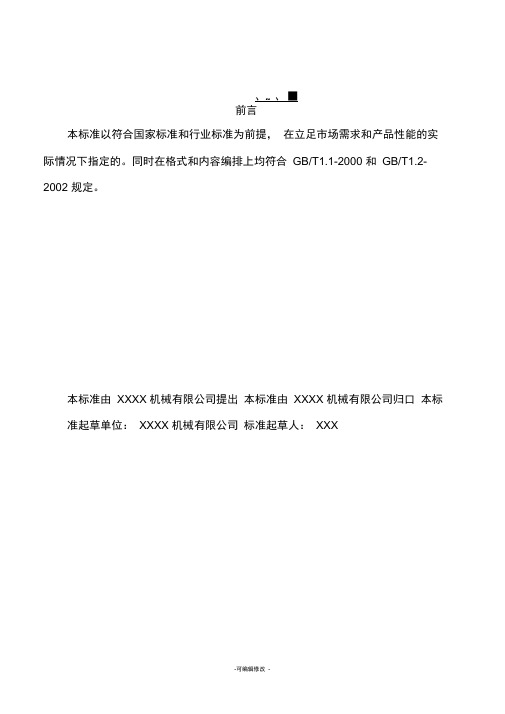
、尸■、■前言本标准以符合国家标准和行业标准为前提,在立足市场需求和产品性能的实际情况下指定的。
同时在格式和内容编排上均符合GB/T1.1-2000 和GB/T1.2-2002 规定。
本标准由XXXX 机械有限公司提出本标准由XXXX 机械有限公司归口本标准起草单位:XXXX 机械有限公司标准起草人:XXX汽车球头销台架试验标准1 范围本标准规定了XX 公司悬架使用的球销节(以下简称“球销总成” )的有关台架试验的方法和技术要求。
本标准适用于XX 公司的所有汽车悬架球销总成。
2 规范性引用文件下列文件中的条款通过标准的引用而成为本标准的条款。
凡是注日期的引用文件,其随后的修改单(不包括勘误的内容)或修订版均不适合与本标准,然而,鼓励根据本标准达成协议的各方研究是否可以使用这些文件的最新版本,凡是不注日期的引用文件,其最新版本适用用本标准。
GB/T 7762-2003 硫化橡胶或热塑性橡胶耐臭氧龟裂静态拉伸试验JIS K 6301 硫化橡胶的物理试验方法3 目的本标准的目的是使球销总成的性能、强度和耐久性试验的试验方法标准化,以便得到评定质量的统一方法。
4 试验种类(1)摆角试验(2)力矩试验(3)刚度试验(4)挤压和拉伸强度试验(5)球头销静态强度试验6)疲劳强度试验7)工作温度下的耐磨持久性试验(8)高温下的耐磨持久试验(9)耐泥水持久性试验(10 )防尘罩耐臭氧试验(11 )防尘罩低温试验(12 )防尘罩耐热性试验(13 )防尘罩拉伸强度试验5 试验的一般条件试验条件一般适用于上面列举的所有试验,内容如下;(1)除非另有规定,试验应在常温常压下进行;(2)试验件应固定在刚度足够大的装置上,这样才不会消弱试验目的;(3)安装夹具的形状应不影响试验目的;6 球销总成试验方法6.1 摆角试验这个试验是测量球销的工作摆角,按如下方法进行6.1.1 试验装置如图 1 所示,把销总成安装在试验夹具上6.1.2 试验条件测量方向:如图 1 所示,使球头销铅垂直立,沿 A 方向和 A 方向垂直的 B 方向进行测量6.1.3试验步骤利用如图2所示测量仪器确定摆角摆角是最大可以摆动的角度,在这个角度范围内,球头销不与任何零件相抵触6.1.4测量项目和记录(见图3)摆角是机械上能摆动的角度6.2 力矩试验该试验是用来测试球销总成转动和摆动力矩,其方法如下。
汽车简式减振器台架试验方法

减振器台架试验及评定方法 主题和范围:本方法规定了PLD 汽车悬架用筒式减振器的台架试验和试验件评定方法。
本方法包含筒式减振器的示功试验、速度特性试验、温度特性试验、耐久性试验。
1 示功试验1.1 目的:测取试件的示功图和速度图。
1.2 设备:PLD 系列微机控制电液伺服汽车减振器试验台。
1.3 条件:1.3.1 试件温度:20士2℃。
1.3.2 试件试验行程S :(100±1)mm 。
1.3.3 试件频率n :(100±2) c 、p 、m 。
1.3.4 速度ν根据1.3.2和1.3.3并由下式决定的减振器活塞速度。
(m /s )5201064.n S π=⨯∙∙=-ν 1.3.5 方向:铅垂方向。
1.3.6 位置:将减振器拉伸至最大行程并测定其行程中间位置A m ,并纪录。
1.4 试验方法1.4.1 按1.3加振,待f P 、y P 微机显示值稳定后,停止试验并记录相应得数值。
f P …………复原阻力,N ; y P …………压缩阻力,N ;1.5 评定1.5.1 示功图应丰满、圆滑,不得有空程、畸形等。
1.5.2 减振器在示功试验中,不得有漏油和明显的噪声等异常现象。
1.5.3 复原阻力和压缩阻力应符合附录A 要求,复原阻力和压缩阻力的允差值应符合下式规定: 复原阻力的允许差值为±(14%f P +40)N ,f P —额定复原阻力;压缩阻力的允许差值为±(14%y P +40)N ,y P —额定压缩阻力;2 速度特性试验2.1 目的:检测减振器在不同活塞速度下的阻力,取得试件的速度特性。
2.2 设备:PLD 系列微机控制电液伺服汽车减振器试验台。
2.3 温度条件:试件温度:20±2℃试件试验行程S :20~100 mm ,速度)/(.s m 520=ν;最高速度须高于1.5 m /s 。
方向:铅垂方向。
位置:A m 。
试验方法:本方法采用多工况合成法测试速度特性P 一v 曲线每个测点工况皆按本标准1.4实施;最后如图4所示取得试验速度特性:2.4评定具体要求:符合图纸技术要求。
第十五章 汽车悬架装置检测

第十五章汽车悬架装置检测GB18565-2001规定对于最大设计车速大于或等于100km/h、轴载质量小于或等于1500kg的载客汽车,应按规定进行悬架特性检测。
第一节汽车悬架装置检验台及检验方法一、汽车悬架装置检验台结构与工作原理目前悬架装置试验台,根据其结构型式可分为跌落式和谐振式两类。
跌落式悬架装置试验台测试开始时,先通过举升装置将汽车升起一定高度,然后突然松开支撑机构,车辆自由振动,可用测量装置测量车辆振幅,或者用压力传感器测量车轮对台面的冲击力,对压力波形进行分析,以此评价汽车悬架装置的性能。
谐振式悬架装置试验台(如图2-15-1)通过电机、偏心轮、储能飞轮、弹簧组成的激振器,迫使汽车悬架装置产生振动,在开机数秒后断开电机电源,从而电储能飞轮产生扫频激振。
由于电机的频率比车轮固有频率高,因此,飞轮逐渐减速的扫频激振过程总可以扫到车轮固有频率处,从而使台面──汽车系统产生共振。
测量此振动频率、振幅、输出振动波形曲线,以系统处理评价汽车悬架装置性能。
图 2-15-1谐振式悬架试验台结构原理图二、谐振式悬架装置检测台检验1.检验方法(1) 汽车轮胎规格、气压应符合规定值,车辆空载,不乘人(含驾驶员)。
(2) 将车辆受检轴车轮驶上悬架装置检测台,使轮胎位于台面的中央位置。
(3) 启动检测台,使激振器迫使汽车悬挂产生振动,使振动频率增加过振荡的共振频率。
(4) 电机转速稳定后切断电机电源,振动频率逐渐降低,并将通过共振点。
(5) 记录衰减振动曲线(如图2-15-2),纵坐标为动态轮荷,横坐标为时间。
测量共振时动态轮荷。
计算并显示共振时的最小动态车轮垂载荷与静态车轮垂载荷的百分比值及其同轴左右轮百分比的差值。
图2-15-2 衰减振动曲线图2.检测标准GB18565-2001规定,用悬架检测台检测时受检车辆的车轮在受外界激励振动下测得的吸收率(被测汽车共振时的最小动态车轮垂直载荷与静态车轮垂直载荷的百分比值)不得小于40%,同轴左右吸收率之差不得大于15%。
减震器技术标准与台架试验方法

QC/T ××××—××××汽车减振器技术条件与台架试验方法汽车减振器技术条件与台架试验方法1 范围本标准规定了汽车减振器技术条件和台架试验方法。
本标准适用于汽车悬架用减振器及驾驶室悬置用减振器。
2 术语和定义下列术语和定义适用于本标准。
2.1双筒式减振器无导向作用的、由工作缸和外筒组成的减振器。
2.2支柱式减振器由工作缸、外筒及其他部件,如弹簧盘、支架等组成的减振器,通常起悬架导向作用,承受侧向力,故活塞杆直径相应较大。
2.3示功特性(阻力特性)减振器在规定的行程和试验频率下,两端作相对简谐运动,其阻力(F)随位移(S)的变化关系为阻力特性,其所构成的曲线(F-S)称示功图。
2.4速度特性减振器在规定的行程和多种试验频率下,两端作相对简谐运动时,其阻力(F)与速度(V)的关系为速度特性。
在多种速度下所构成的曲线(F-V)称速度特性图。
2.5温度特性减振器在规定的速度下,并在多种温度的条件下,所测得的阻力(F)随温度(t)的变化关系为温度特性,其所构成的曲线(F-t)称温度特性图。
2.6耐久特性减振器在规定的工况条件下,在规定的运转次数后,其特性的变化称为耐久特性。
2.7摩擦力(Fm)减振器以≤0.005m/s的速度,其力定义为摩擦力。
2.8充气力(Fc)对于充气减振器,活塞处于行程的中间位置时,气体作用于活塞杆上的力为充气力。
2.9抗泡沫性减振器在规定的条件下,重复运动后,减振器内的油可能产生泡沫。
其示功特性抗泡沫影响的能力。
3 符号和缩略语额定阻力F (N)额定复原阻力Ff (N)额定压缩阻力Fy (N)行程S (mm)试验频率 f (Hz)活塞速度V (m/ s)摩擦力Fm (N)复原时摩擦力Fmf (N)压缩时摩擦力Fmy (N)温度特性试验时,试验前、后复原及压缩阻力的变化率εf , εy台架耐久性试验时,试验前、后复原及压缩阻力的变化率εnf ,εnyL1:最小压缩长度S:行程L1+S:最大拉伸长度D2:防尘罩外径D1:贮液缸外径M:螺纹连接尺寸HH:两端吊环型HG:上端吊环下端螺杆型GH:下端吊环上端螺杆型GG:两端螺杆型4.2.3 减振器的工作行程及长度按照实际需要设定。
JASO C304-1989 汽车半轴等速万向节(中文版)

汽车半轴等速万向节1范围本标准规定了汽车半轴等速万向节。
本文对两轮车辆、工业建设车辆、农业机械同样适用。
备注:本标准中,单位和数值均基于SI(国际单位制),但{}中给出的数值是基于传统单位制并给出参考文献。
2目的本标准旨在标准化等速万向节的主要规格,因此设计和处理均需合理化。
3定义本标准中应用的主要词语在下面定义:(1)半轴一个传递动力的旋转轴,连接两套或者一套万向节、中间轴等组成,安装在末端减速齿轮和车轮之间。
(2)等速万向节在每个工作角度上输入轴和输出轴角速度相等的万向节。
(3)中心固定型等速万向节只改变工作角度的万向节。
(4)伸缩型等速万向节能选择工作角和伸缩运动的万向节。
(5)三球销式万向节(固定型)三脚架固定在三叉槽壳内,装在三销架三个轴线的球环和叉状轴形成工作角度的中心固定型等速万向节。
(6)三球销式万向节(伸缩型)球环装在三叉槽壳沿轴向直线平行的辊槽三个轴线上伸缩型等速万向节。
(7)十字槽型等速万向节(VL)滚球由在内、外圈直沟道交叉处具有外球面的保持架夹,轴向等角度相互转动的伸缩型等速万向节(8)外部等速万向节半轴上安装在车轮侧的等速万向节(9)内部等速万向节半轴上装在差速器或末端减速齿轮侧的等速万向节。
(10)名义轴径作为尔泽泊等速万向节最小静态扭转破坏抗性和允许接合角参考的的轴径。
名义轴径应该在轴径极限之间去中值。
(11)许用工作角度等速万向节可以传递驱动力的最大工作角,任何工作角超过该值的万向节是无效的,如果超过了,等速万向节零件会发生干涉。
(12)旋转间隙旋转方向的间隙(13)最小静扭矩破坏强度当半轴在0工作角和扭转转速小于6.3rad/min(360/min)抗扭破坏的极限值。
(14)末段封闭型安装部位为实心轴的等速万向节。
(15)轴套型等速万向节安装部位为空心轴的等速万向节。
(16)法兰型安装部位为带螺栓孔的法兰的等速万向节(17)轮盘型安装部位为带贯通螺栓孔的轮盘的等速万向节4类型等速万向节的种类如表1所示5性能5.1许用工作角度球笼式等速万向节(Rezppa)、可轴向移动的球笼式万向节(DOJ)、三球销等速万向节(可伸缩式)的许用工作角如表2所示。
- 1、下载文档前请自行甄别文档内容的完整性,平台不提供额外的编辑、内容补充、找答案等附加服务。
- 2、"仅部分预览"的文档,不可在线预览部分如存在完整性等问题,可反馈申请退款(可完整预览的文档不适用该条件!)。
- 3、如文档侵犯您的权益,请联系客服反馈,我们会尽快为您处理(人工客服工作时间:9:00-18:30)。
1, measurements shall be taken in
tomary units system, and are given for room temperature.
reference.
(2) A test piece shall be mounted with
(IO)Dust cover ozone-deterioration test
dures relating to the ball joint employed in an
(12) Dust cover heat resistance test
(hereinafter referred to as "ball joint").
Automotive Rubber Parts
JASO Z 204-84 Glossary of Terms to Suspension of Automobiles
onto a jig. (3)Testing steps
(9) Muddy water durability test
This standard specifies the bench test proce-
strength and durability of the ball joints which (3) A mounting jig shall be so shaped as
are employed in a suspension of independenurpose of testing.
----------------------- Page 1-----------------------
JAPANESE AUTOMOBILE STANDARD JASO C615-89
This test shall be conducted to evaluate the Direction A and in Direction B right-
oscillation angle of a ball joint as follows: angled to Direction A from the posi-
2. k this standard, units and numerical
values are based on SI (International (1) Unless otherwise specified, testing shall
System of Units!, while units and
numerical values given in { 1 are cus- be conducted in an atmosphere at the
Applicable Standards: JIS K 6301-75 Physical Testing Methods for Vulcanized Rubber
JIS Z8901-74 Dusts and Aerosols for Industrial Testing
SAE J 193 SEP 79 Ball Stud and Socket Assembly Test Procedure
1
Reference Standards: JASO C 710-87 Test Code of Strength and Rigidity for Steering
Column
Remarks: 1. This standard does not include a sus-
ension arm and its fastener. 4. Common Test Conditions
JASO 2 213-76 Glossary of Terms Relating to Steering Systems
of Automobiles
This standard aims to standardize the test taken to the extent that the purpose of
procedures relating to the performance, testing might not be impaired.
Bench Test Procedures of Suspension
Ball Joint for Independent Type
1. Scope (8) Abrasive durability test
(11) Dust cover low temperature test
automotive suspension of independent type
JASO F 981-70 Ball Studs and Sockets
JASO M 322-85 Heat Aging and Low Temperature Tests for
type so as to obtain generalization of quality
evaluation.
3. Types of Testing
Oscillation angle test
Torque test
Rigidity test
----------------------- Page 2-----------------------
JAS0 C615-89
5. Ball Joint Test Method (2)Test conditions
Extrusion and drawing strength test
Ball stud static strength test
Dust cover drag strength test
Fatigue strength test
proper dimensions for the installation
2. Purpose
and a sufficiently rigid means shall be
JASO C 715-88 Bench Test Procedures of Steering Ball Joint for
Rack and Pinion Type
(1) Test setup tion at which the ball stud stands
As shown in Fig. 1, mount the ball joint vertically.
